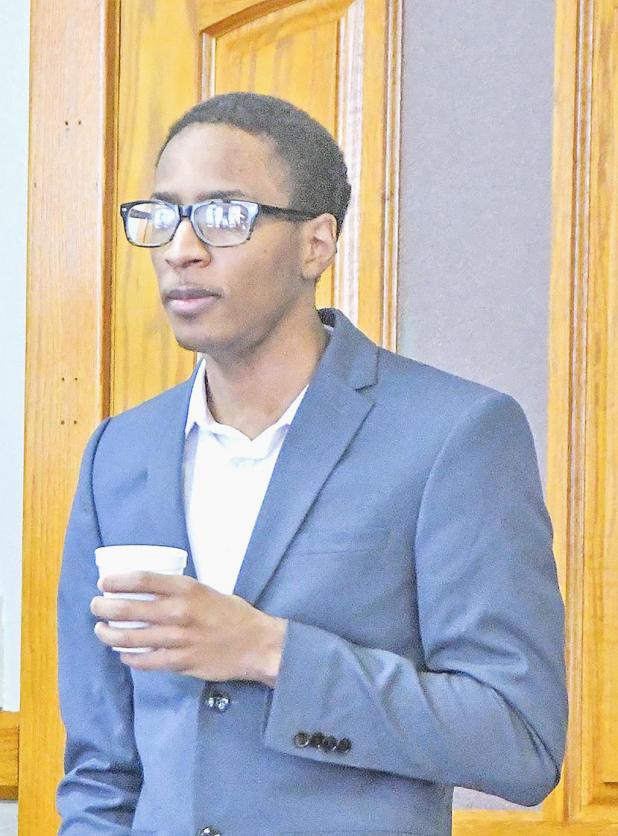

Russ Pankonin | For The Imperial Republican
Kevin German enters the Chase County District Courtroom as another day in his trial got underway this week.
Defense team for German calls three witnesses
Kevin German’s defense team in his murder and kidnapping trial rested their case after calling just three witnesses Monday.
On Tuesday, closing arguments by the prosecution and defense got underway.
Video deposition
as testimony
The defense used the 90-minute videotaped deposition from an expert witness on toxicology to counter testimony given by a prosection witness.
Last week, the jury heard from forensic expert Dr. Tim Rohrig, who specializes in forensic pharmacology and toxicology.
Rohrig said formic acid from the breakdown of ingested methanol was a factor in the death of Annika Swanson.
The video deposition from Dr. Michael Kosnett of Denver, Colorado was in lieu of a court appearance. Defense Attorney Clarence Mock and Prosecutors Doug Warner and Mike Guinan took part in the deposition last month on July 13.
Kosnett is a practicing physician, specializing in medical toxicology and occupational and environmental medicine.
Kosnett has a 1979 degree in molecular biophysics and biochemistry from Yale University. He then attended medical school at the University of California-San Francisco, earning his degree in 1983.
After completing a residency in internal medicine at the University of Washington, he did a second residency in occupational and environmental medicine at UCSF.
He also obtained additional training in medical toxicology at UCSF. He is board certified in internal medicine, occupational medicine and medical toxicology.
He joined the teaching staff at the UCSF for six years and is presently an associate professor at the University of Colorado Medical School and Colorado School of Public Health.
Mock explained Kosnett was hired by the defense team to review the records of autopsy and toxicology reports in the death of Annika Swanson.
He explained the molecular composition of ethanol and methanol, and said ethanol, which is the alcohol in liquors, breaks down in the body into calories.
With methanol, he said the body first creates formaldehyde when it starts to break down methanol. When it’s fully metabolized, methanol becomes formic acid, which is very toxic.
He explained the body can break down low levels of methanol but it’s when large amounts are ingested that it becomes a risk.
Methanol itself is not toxic and a person can have a substantial amount of methanol without it becoming toxic, he said. It becomes toxic when the formic acid starts to form.
He said the drug Fomepizole is used as an antidote in confirmed or suspected methanol or ethylene glycol poisoning. Mock asked Kosnett for his opinion “to a reasonable degree of medical certainty in the field of medical toxicology whether methanol ingestion caused or contributed to Annika Swanson’s death.”
Kosnett responded, “My opinion, after carefully considering the medical records, the toxicology reports and the toxicology literature, is that it cannot be concluded with reasonable medical certainty that methanol caused or contributed to Annika Swanson’s death.”
He cited the toxicology report on Swanson, showing her body contained 6.6 micrograms per milliliter of formic acid. Based on that level, he suspected Swanson died before the methanol present in her body had been converted to formic acid.
There is a latent period of 12 to 24 hours, he said, before the body starts to convert the methanol into formic acid
He said there are natural levels of formic acid in the body, with a range of six to 12 micrograms per milliliter.
Kosnett followed by citing a number of research findings and studies that backed up his opinion. He disagreed with several of Rohrig’s opinions offered during his testimony.
“So the bottom line, Dr. Kosnett, is the consumption by Swanson of methanol didn’t have anything to do with her death,” Mock said.
“That’s my opinion. Yes. It had nothing to do with it,” Kosnett responded.
Prosecution questioning
Warner conducted a cross-examination of Kosnett.
Warner noted toxicology showed Swanson had 170 milligrams per deciliter in her body.
“Would have that amount been enough to kill her?” he asked.
“Yes. Now a level of 170, if not treated, and that went on to be converted to formic aid, that could cause serious toxicity. I agree with that,” Kosnett said.
She was going to die from formic acid poisoning at that level, Warner stated.
Kosnett noted he couldn’t conclude, with medical certainty, that Swanson was going to die.
“It’s possible. I can’t say for sure she wouldn’t, but it’s possible,” he said.
The only other witnesses called by the defense were Abbi Murillo and Sheriff’s Deputy Duncan Einspahr.
Both had testified earlier in the trial.
After the state rested its case, Mock motioned the judge to dismiss the case, saying the prosecution had not met the burden of proof.
District Judge Patrick Heng denied the motion and directed the defense to move forward.
After the defense rested, Mock made the same request, which was again denied.
